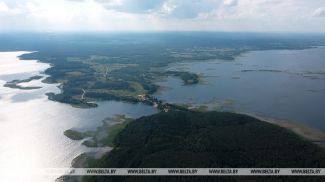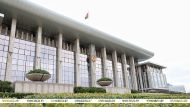
MINSK, 29 April (BelTA) – The Nuclear and Radiation Safety Department of the Belarusian Emergencies Ministry (Gosatomnadzor) has published a report on the state of nuclear and radiation safety in Belarus, BelTA learned from Yekaterina Shmeleva, Deputy Head of the Office for Managing Radioactive Waste and Nuclear Legacy Facilities at Gosatomnadzor.
Yekaterina Shmeleva said: “Abiding by the policy of openness and transparency as well as by the undertaken international commitments, as the Belarusian regulatory body in the field of nuclear and radiation safety Gosatomnadzor regularly prepares and disseminates up-to-date information about this sphere for the general public in Belarus and abroad. Preparing reviews on the state of nuclear and radiation safety in Belarus is part of the work. These reviews are analytical reports, which have been prepared regularly since 2014 as part of Gosatomnadzor’s responsibility to the population and the general public of Belarus. It is important for us not only to talk about what happened over the past year and what work was done but how it affected safety matters.”
On its official website Gosatomnadzor has published a report on the state of nuclear and radiation safety in 2023. The report consists of three parts. The first one covers significant infrastructure events.
“It was a momentous year in Belarus. The first nuclear power plant consisting of two power-generating units was commissioned. An integral body of laws on safety precautions at facilities that use nuclear energy was also put together. The new law on regulating safety in the course of using nuclear energy came into force. All the bylaws were brought into compliance with this law and technical laws and statutory instruments in the field of nuclear and radiation safety were updated. Apart from that, the Council of Ministers passed a resolution on the strategy on managing radioactive waste. It is a complex program document, which stipulates a system of official views and approaches to making managerial decisions with a view to ensuring safe, technically optimal, and economically effective management of radioactive waste,” the official said.
The first part of the review also covers the fulfillment of international obligations and international cooperation.
The second part of the review is dedicated to evaluating the state of safety at nuclear energy facilities. Those are the Belarusian nuclear power plant, the joint energy and nuclear research institute Sosny, and facilities that manage radioactive waste: the Ekores enterprise, sites for burying the waste generated by decontaminating sources of ionizing radiation, other sources of radiation impact such as territories affected by the accident at the Chernobyl nuclear power plant, radiation hazardous lands, and the Polesie State Radiation and Ecological Reserve.
“A lot of attention is paid to results of radiation monitoring, radiation hygienic monitoring, and radiation control in food, raw materials, radiation protection of the population. The third part of the review presents information about scientific and technical support for efforts meant to ensure nuclear and radiation safety at premises of scientific organizations and higher education institutions of the agricultural, biological, and medical varieties. Their competences were used in the course of alleviating consequences of the Chernobyl nuclear power plant catastrophe,” said the deputy head of the Office for Managing Radioactive Waste and Nuclear Legacy Facilities at Gosatomnadzor.
In her words, the system of scientific and technical support constantly develops and gets improved. The review presents information about the realization of projects and events envisaged by government programs and about the formation of projects of programs of the Union State of Belarus and Russia. More details are available on pages of the third part of the review. “This part contains information about the information work being constantly done during annual visits to affected areas. Information work makes a substantial contribution to forming the culture of life safety among the people, who live in affected areas. It increases the qualifications of professional groups in the healthcare system in order to improve the quality of medical services to targeted population categories and in order to help farmers grow clean products. The information work also helps reduce risks associated with living in polluted territories,” Yekaterina Shmeleva stated.
Materials submitted by organizations affiliated with the National Academy of Sciences of Belarus, the Healthcare Ministry, the Energy Ministry, and the Natural Resources and Environmental Protection Ministry were used in the course of preparing the review.













